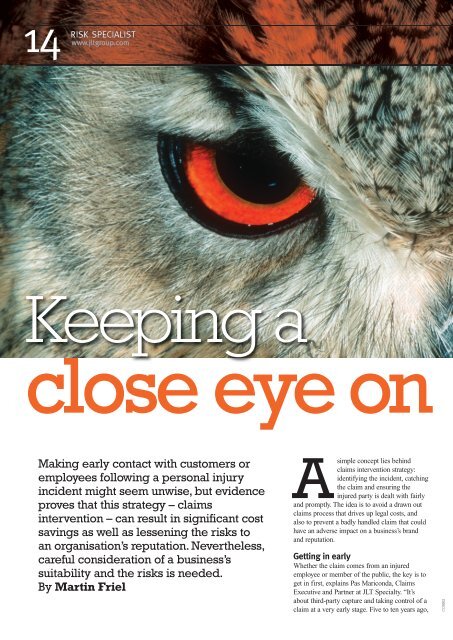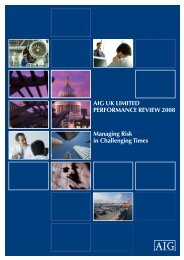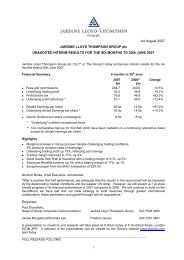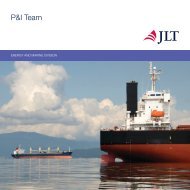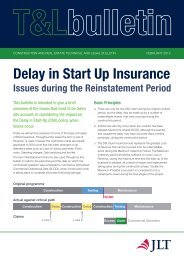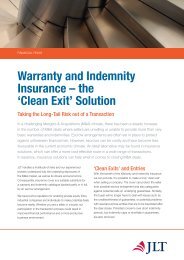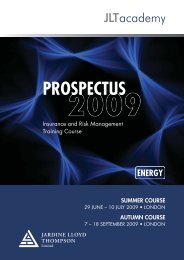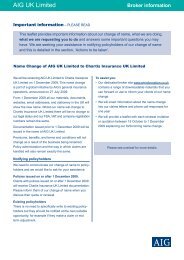Risk Specialist June 2012 - JLT
Risk Specialist June 2012 - JLT
Risk Specialist June 2012 - JLT
Create successful ePaper yourself
Turn your PDF publications into a flip-book with our unique Google optimized e-Paper software.
14 RISK<br />
RISK SPECIALIST<br />
www.jltgroup.com<br />
Keeping a<br />
close eye on<br />
Making early contact with customers or<br />
employees following a personal injury<br />
incident might seem unwise, but evidence<br />
proves that this strategy – claims<br />
intervention – can result in significant cost<br />
savings as well as lessening the risks to<br />
an organisation’s reputation. Nevertheless,<br />
careful consideration of a business’s<br />
suitability and the risks is needed.<br />
By Martin Friel<br />
A<br />
simple concept lies behind<br />
claims intervention strategy:<br />
identifying the incident, catching<br />
the claim and ensuring the<br />
injured party is dealt with fairly<br />
and promptly. The idea is to avoid a drawn out<br />
claims process that drives up legal costs, and<br />
also to prevent a badly handled claim that could<br />
have an adverse impact on a business’s brand<br />
and reputation.<br />
Getting in early<br />
Whether the claim comes from an injured<br />
employee or member of the public, the key is to<br />
get in first, explains Pas Mariconda, Claims<br />
Executive and Partner at <strong>JLT</strong> Specialty. “It’s<br />
about third-party capture and taking control of a<br />
claim at a very early stage. Five to ten years ago,<br />
CORBIs
CLAImS INTERvENTION<br />
JUNE <strong>2012</strong><br />
15<br />
Insurance can<br />
help bridge the<br />
gap between<br />
seller and buyer<br />
in negotiations<br />
claims<br />
the strategy would have been to view the third<br />
party as an adversary and wait for the letter of<br />
claim to arrive.”<br />
For the claim intervention strategy to work,<br />
a company must be able to identify incidents<br />
and contact the affected party before they turn<br />
to a solicitor. Only accurate incident reporting<br />
can provide the information needed to do this.<br />
Once contact has been made, it must be<br />
established whether or not an injury has<br />
occurred and, if so, whether there is liability.<br />
If the business is liable, an appropriate redress<br />
should be offered to the injured party.<br />
Identifying suitable businesses<br />
While this sounds simple, any claims<br />
intervention strategy must be appropriate for<br />
the risks a business is exposed to. Getting the<br />
processes right is absolutely vital – if it is not<br />
handled properly, the claims intervention<br />
strategy could end up doing the company<br />
more harm than good.<br />
I can’t think of one sector, other than the<br />
legal profession, that wouldn’t like less<br />
involvement from solicitors in lower value claims.<br />
”<br />
Richard Gurney, Claims Managing Director, <strong>JLT</strong> Specialty<br />
Many businesses could potentially benefit,<br />
says Richard Gurney, Claims Managing<br />
Director at <strong>JLT</strong> Specialty. “With so many<br />
clients retaining a significant proportion of<br />
their claims spend, in one form or another,<br />
there is a relevance well beyond just the<br />
largest insurance buyers.”<br />
Businesses that have greater than normal<br />
liability exposures arising from an employer<br />
liability claims culture or high footfall levels,<br />
such as those in leisure, property and retail,<br />
are most likely to benefit from savings.<br />
Simon Pemberton, Sales Director at<br />
Gallagher Bassett International, a claims<br />
handling company, explains that any<br />
business that is experiencing a large<br />
number of public and employers’<br />
liability claims each year should<br />
»»
16<br />
RISK SPECIALIST<br />
www.jltgroup.com<br />
»»<br />
consider corrective action. If the cost of<br />
these claims is increasing and is affecting<br />
profitability, there is a strong argument for a<br />
claims intervention strategy. But even so, it<br />
may not be suitable.<br />
Ian Thompson, Partner in <strong>JLT</strong> Specialty’s<br />
<strong>Risk</strong> Practice and former Head of Group<br />
Insurance at a large rail company, has seen the<br />
difficulties first-hand. “It’s more complex – in<br />
a rail accident you could have the main rail<br />
company, contractors, the infrastructure owner<br />
and potentially the train maintainer all<br />
involved in the claim,” he explains.<br />
Such complexities do not mean that the<br />
company has to abandon the idea of a claims<br />
intervention strategy altogether. Thompson<br />
points out that, although it was not suitable to<br />
be rolled out company-wide, a claims<br />
intervention strategy was applied to the<br />
company’s motor risks. Liability is typically<br />
less complicated with these types of claims –<br />
they are generally low severity and low cost<br />
so it should be possible to settle without<br />
bringing solicitors into the equation. Indeed,<br />
identifying the less complex claims and where<br />
unnecessary litigation and aggravation can be<br />
avoided – especially through the involvement<br />
of solicitors – is an essential part of an<br />
effective strategy.<br />
Solicitors’ costs<br />
In fact, solicitors’ costs are one of the major<br />
reasons for implementing an intervention<br />
strategy. It’s no secret that as soon as a<br />
solicitor gets involved in the claims process,<br />
the costs increase markedly. As Gurney puts<br />
it: “I can’t think of one sector, other than the<br />
Top tips for incident recording<br />
It is a legal requirement to report any accidents in the workplace that involve either members of<br />
staff or the public. When recording an incident make sure that the following is noted:<br />
• Full name, address and occupation of the injured person<br />
• Date and time of the accident<br />
• Location of the accident<br />
• Cause and nature of the injury<br />
Taking the plunge:<br />
companies may not<br />
see instant benefits<br />
legal profession, that wouldn’t like to see less<br />
involvement from solicitors in the lower value<br />
claims. And this is certainly the view that the<br />
government are now taking, with a raft of<br />
measures planned to combat excessive costs.”<br />
Of course, nobody will be denied access to<br />
justice if correct processes are followed. An<br />
injured individual that has been identified as a<br />
potential claimant must be informed at the<br />
earliest stage of their entitlement to bring a<br />
solicitor into the process. Also, there must be<br />
no suggestion that there is an attempt to<br />
unfairly reduce the damages element of the<br />
claim – it’s about cutting out the unnecessary<br />
• Record the cause or causes of the incident and the nature and severity of the injury. Ensure<br />
that you get witness statements, particularly from the injured person, if possible<br />
• Photograph any damage and injury if possible<br />
• Ensure that, when recording the incident, no blame is placed on any individual or group. The<br />
aim should be to report the facts impartially<br />
costs incurred through litigation. The ABI has<br />
published guidelines on dealing fairly with<br />
unrepresented claimants, which are readily<br />
accessible from its website under the heading<br />
‘Third Party Assistance’.<br />
As Nick Bonser, Deputy Managing Director<br />
of Gallagher Bassett, says: “Fundamentally,<br />
claims intervention is about providing access to<br />
justice and delivering swift, prompt and fair<br />
settlements. We should be able to achieve that<br />
without solicitors on a proportionate level of<br />
cases.”<br />
This is a persuasive argument for relatively<br />
simple claims that do not involve long term<br />
injury. Some companies that have taken on a<br />
strategy have witnessed an overall cost<br />
reduction of 25-30 per cent.<br />
Mariconda says successful implementation can<br />
have a beneficial effect on a company’s risk<br />
profile. While stressing that there would not<br />
necessarily be an immediate reduction in<br />
premiums paid, he points to longer term benefits.<br />
“They will not receive a reduction in premium<br />
just for having a strategy but reducing claims<br />
costs along the way should hopefully improve<br />
the claims experience, which over time makes<br />
the risk itself more attractive.”<br />
But there is more to claims intervention than<br />
simple cost cutting. Brand is of immeasurable<br />
value to any business. A successful claims<br />
intervention strategy can become a fundamental<br />
part of brand protection and reputation.<br />
Getty Images
claims intervention<br />
17<br />
JUNE <strong>2012</strong><br />
Dixons: buy-in, clear objectives and a proper process<br />
Hoping to improve customer service and reduce costs, high<br />
street retailer Dixons Retail plc, owner of Currys and PC World,<br />
introduced a claims intervention strategy in 2010. The group’s<br />
Head of Insurable <strong>Risk</strong>, Andrew Hanton, says that by settling<br />
claims quickly, stripping out unnecessary activity and taking<br />
out the need for customers to deal with solicitors, Dixons is<br />
witnessing a 50 per cent reduction in legal costs and a fall in<br />
overall injury claims costs in excess of 25 per cent.<br />
Hanton advises anyone looking to implement such a<br />
strategy to focus on three main aspects: first, identifying key<br />
senior stakeholders, building buy-in and getting a board<br />
member to ‘sponsor’ the project; second, providing clear<br />
project objectives and ensuring stakeholders understand them;<br />
and finally taking the time properly to map out and stick to a<br />
clear process with clear roles and responsibilities, timelines<br />
and terms of reference.<br />
But what does that look like in practice? First and foremost,<br />
all accidents involving members of the public and staff must<br />
be properly recorded and logged. Incidents can then be<br />
analysed and a decision can be made on whether or not there<br />
is liability. If there is, swift contact must be made and the<br />
claimant given appropriate compensation or access to<br />
rehabilitation. Without proper and accurate reporting, the<br />
whole strategy will collapse.<br />
How did Dixons manage to ensure that its 700 sites were<br />
complying? Hanton says that engagement from those at a<br />
bbnmbbm<br />
mbmnbmb<br />
local level mbnbmnnb needs to be part of the culture. Sanctions may need<br />
to be imposed on those that do not toe the line; to<br />
encourage adoption, individual stores should see the results<br />
of non-compliance impact on their own profit and loss.<br />
For instance, if a store is not playing ball, Dixons will send<br />
an investigator from its claims handler to ascertain what is<br />
happening. The store will pay for that cost. If a store’s inaction<br />
results in Dixons paying a claim it wouldn’t otherwise have<br />
faced, the store will foot 25 per cent of the bill.<br />
Performance indicators<br />
These measures are working for Dixons, but how can other<br />
businesses see if they are heading in the right direction?<br />
Hanton says that the key performance indicators (KPIs) are<br />
pretty clear cut. The number of claimants who agree to a fair<br />
settlement with no subsequent approach from legal<br />
representatives can be tracked relatively easily. If accurate<br />
records are kept, a company should be able to compare the<br />
year-on-year cost of accidents where a liability attaches.<br />
Other important indicators, which show how customers are<br />
treated following an accident, are the average accident<br />
reporting time and the average settlement time. Dixons<br />
doesn’t want the small number of customers injured in its<br />
stores suffering more than they already have. Hanton advises<br />
reviewing these KPIs on a monthly basis until the strategy is<br />
bedded in, and quarterly thereafter.<br />
Reputational benefits<br />
There can be serious reputational fallout from<br />
a customer injured on a business’s premises if<br />
the claim is handled badly, especially in the<br />
age of social media. Multiply one disgruntled<br />
client by 500 and it is easy to see how the<br />
absence of a cohesive claims strategy can<br />
have a detrimental impact on reputation.<br />
Trumpeting a new claims-friendly stance<br />
may not always be advisable, however. Being<br />
perceived as a ‘soft touch’ for fraudulent<br />
claims may attract fabricated or exaggerated<br />
claims in the hope of a payout so there is a<br />
balance to be struck. Detailed investigation of<br />
incidents is still therefore an invaluable factor,<br />
and full and accurate data capture will help<br />
companies to identify any fraud.<br />
Claims intervention is<br />
about providing access<br />
to justice and delivering swift,<br />
prompt and fair settlements.<br />
”<br />
Nick Bonser, Deputy Managing Director, Gallagher Bassett<br />
Companies that have adopted this approach<br />
attest to its effectiveness in reducing costs and<br />
improving customer sentiment. John Searing,<br />
Partner at <strong>JLT</strong> Specialty’s Real Estate<br />
division, has seen the benefits himself.<br />
Before joining <strong>JLT</strong> Specialty, he was a risk<br />
manager for a pension fund that had a large<br />
shopping centre in its portfolio. They took the<br />
decision to identify and tackle claims as early<br />
as possible.<br />
“When we trialled this process at the<br />
shopping centre, we found that genuine<br />
claimants don’t want as much money as<br />
possible: they want to recover from their injury<br />
as fully and as quickly as possible,” he says.<br />
Searing found that intervention increased<br />
the proportion of claims that were settled<br />
without a solicitor. “Overall<br />
payments actually reduced,<br />
although we had more cases<br />
where we paid out.”<br />
Still, seeing the<br />
possibility of the number of<br />
claims rise tends to frighten<br />
off many potential adopters<br />
– the concept of contacting<br />
an injured individual before they formally<br />
pursue a claim, in order to reduce claims<br />
costs, can be difficult to accept. New<br />
adopters clearly need to hold their nerve as<br />
claims volumes possibly rise.<br />
Think long term<br />
Focusing on the outcome can help to stiffen<br />
resolve. Significant savings and a better<br />
protected brand are hard to argue with. A<br />
good broker will be able to guide their client<br />
through the set-up process. At a basic level,<br />
detailed investigation and comprehensive<br />
incident reporting, combined with prompt<br />
action, are all that is required.<br />
The benefits of a well-thought out, wellimplemented<br />
and well-managed claims<br />
intervention strategy should begin to show<br />
within two years. Provided the necessary<br />
focus and attention are maintained, the cost<br />
savings and brand benefits will be<br />
longstanding. RS<br />
Pas_Mariconda@jltgroup.com<br />
Martin Friel is a former Editor of Insurance Age.


